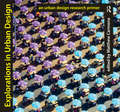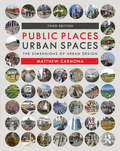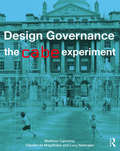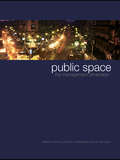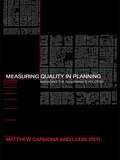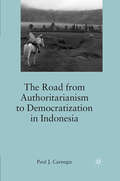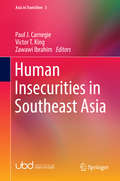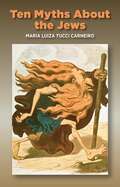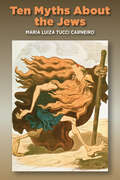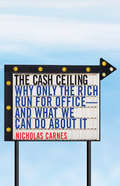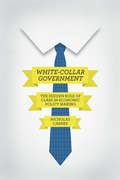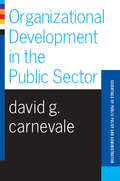- Table View
- List View
Explorations in Urban Design: An Urban Design Research Primer
by Matthew CarmonaWhilst recognising that distinctly different traditions exist within the study and practice of urban design, this book advances an interdisciplinary and innovative approach, which is of direct importance to understanding the urban forms, conditions, practices and processes. It enthuses and inspires users who are grappling with urban design research problems, but who need inspiration to move from idea to methodological approach. Through the work of 32 urban researchers from the arts, sciences and social sciences, it demonstrates a wide range of problems and approaches and shows how the diverse range of complementary approaches can come together to provide a holistic understanding to the design of cities. While each of the contributors presents a particular approach to researching the field, sometimes focusing centrally on particular research methodologies, others cutting across methods, or focusing on theory, all include discussion of actual research projects to illustrate their application to 'real world' problems. This book will be valuable to everyone from the informed undergraduate student about to embark on their first dissertation, to PhD students and seasoned researchers immersed in methodological and conceptual complexity and wishing to compare available and appropriate methodological paths.
Public Places Urban Spaces: The Dimensions of Urban Design
by Matthew CarmonaPublic Places Urban Spaces provides a comprehensive overview of the principles, theory and practices of urban design for those new to the subject and for those requiring a clear and systematic guide. In this new edition the book has been extensively revised and restructured. Carmona advances the idea of urban design as a continuous process of shaping places, fashioned in turn by shifting global, local and power contexts. At the heart of the book are eight key dimensions of urban design theory and practice—temporal, perceptual, morphological, visual, social, functional—and two new process dimensions—design governance and place production. This extensively updated and revised third edition is more international in its scope and coverage, incorporating new thinking on technological impact, climate change adaptation, strategies for urban decline, cultural and social diversity, place value, healthy cities and more, all illustrated with nearly 1,000 carefully chosen images. Public Places Urban Spaces is a classic urban design text, and everyone in the field should own a copy.
Public Places Urban Spaces: The Dimensions of Urban Design
by Matthew CarmonaPublic Places Urban Spaces provides a comprehensive overview of the principles, theory and practices of urban design for those new to the subject and for those requiring a clear and systematic guide. In this new edition the book has been extensively revised and restructured. Carmona advances the idea of urban design as a continuous process of shaping places, fashioned in turn by shifting global, local and power contexts. At the heart of the book are eight key dimensions of urban design theory and practice—temporal, perceptual, morphological, visual, social, functional—and two new process dimensions—design governance and place production. This extensively updated and revised third edition is more international in its scope and coverage, incorporating new thinking on technological impact, climate change adaptation, strategies for urban decline, cultural and social diversity, place value, healthy cities and more, all illustrated with nearly 1,000 carefully chosen images. Public Places Urban Spaces is a classic urban design text, and everyone in the field should own a copy.
Design Governance: The CABE Experiment
by Matthew Carmona Claudio De Magalhaes Lucy NatarajanDesign Governance focuses on how we design the built environment where most of us live, work, and play and the role of government in that process. To do so, it draws on the experience of the Commission for Architecture and the Built Environment (CABE), a decade-long, globally unique experiment in the governance of design. This book theorises design governance as an arm and aspiration of the state; tells the story of CABE, warts and all, and what came before and after; unpacks CABE’s ‘informal’ toolbox: its methods and processes of design governance; and reflects on the effectiveness and legitimacy of design as a tool of modern-day government. The result is a new set of concepts through which to understand the governance of design as a distinct and important sub-field of urban design.
Design Governance: The CABE Experiment
by Matthew Carmona Claudio De Magalhaes Lucy NatarajanDesign Governance focuses on how we design the built environment where most of us live, work, and play and the role of government in that process. To do so, it draws on the experience of the Commission for Architecture and the Built Environment (CABE), a decade-long, globally unique experiment in the governance of design. This book theorises design governance as an arm and aspiration of the state; tells the story of CABE, warts and all, and what came before and after; unpacks CABE’s ‘informal’ toolbox: its methods and processes of design governance; and reflects on the effectiveness and legitimacy of design as a tool of modern-day government. The result is a new set of concepts through which to understand the governance of design as a distinct and important sub-field of urban design.
Public Space: The Management Dimension
by Matthew Carmona Claudio De Magalhães Leo HammondIn both the UK and the US there is a sense of dissatisfaction and pessimism about the state of urban environments, particularly with the quality of everyday public spaces. Explanations for this have emphasized the poor quality of design that characterizes many new public spaces; spaces that are dominated by parking, roads infrastructure, introspective buildings, a lack of enclosure and a poor sense of place, and which in different ways for different groups are too often exclusionary. Yet many well designed public spaces have also experienced decline and neglect, as the services and activities upon which the continuing quality of those spaces have been subject to the same constraints and pressures for change as public services in general. These issues touch upon the daily management of public space, that is, the coordination of the many different activities that constantly define and redefine the characteristics and quality of public space. This book draws on three empirical projects to examine the questions of public space management on an international stage. They are set within a context of theoretical debates about public space, its history, contemporary patterns of use and changing nature in western society, and about the new management approaches that are increasingly being adopted.
Public Space: The Management Dimension
by Matthew Carmona Claudio De Magalhães Leo HammondIn both the UK and the US there is a sense of dissatisfaction and pessimism about the state of urban environments, particularly with the quality of everyday public spaces. Explanations for this have emphasized the poor quality of design that characterizes many new public spaces; spaces that are dominated by parking, roads infrastructure, introspective buildings, a lack of enclosure and a poor sense of place, and which in different ways for different groups are too often exclusionary. Yet many well designed public spaces have also experienced decline and neglect, as the services and activities upon which the continuing quality of those spaces have been subject to the same constraints and pressures for change as public services in general. These issues touch upon the daily management of public space, that is, the coordination of the many different activities that constantly define and redefine the characteristics and quality of public space. This book draws on three empirical projects to examine the questions of public space management on an international stage. They are set within a context of theoretical debates about public space, its history, contemporary patterns of use and changing nature in western society, and about the new management approaches that are increasingly being adopted.
Measuring Quality in Planning: Managing the Performance Process
by Matthew Carmona Louie SiehThis book deals with one of the current major debates in planning: how to measure the quality and effectiveness of the output of the planning process. It deals with issues of defining quality, public sector management, the use of indicators and the planning process. Although case study material is drawn from UK practice this topic is universal and the authors include discussions of international practice and experience.
Measuring Quality in Planning: Managing the Performance Process
by Matthew Carmona Louie SiehThis book deals with one of the current major debates in planning: how to measure the quality and effectiveness of the output of the planning process. It deals with issues of defining quality, public sector management, the use of indicators and the planning process. Although case study material is drawn from UK practice this topic is universal and the authors include discussions of international practice and experience.
Capital Spaces: The Multiple Complex Public Spaces of a Global City
by Matthew Carmona Filipa Matos WunderlichIn recent years it has become common-place to hear claims that public space in cities across the globe has become the exclusive preserve of the wealthy and privileged, at the expense of the needs of wider society. Whether it is the privatization of public space through commerical developments like shopping malls and business parks, the gentrification of existing spaces by campaigns against perceived anti-social behaviour or the increasing domination of public areas by private transport in the form of the car, the urban public space is seen as under threat. But are things really that bad? Has the market really become the sole factor that influences the treatment of public space? Have the financial and personal interests of the few really come to dominate those of the many? To answer these questions Matthew Carmona and Filipa Wunderlich have carried out a detailed investigation of the modern public spaces of London, that most global of cities. They have developed a new typology of public spaces applicable to all cities, a typology that demonstrates that to properly assess contemporary urban places means challenging the over-simplification of current critiques. Global cities are made up of many overlapping public spaces, good and bad; this book shows how to analyze this complexity, and to understand it.
Capital Spaces: The Multiple Complex Public Spaces of a Global City
by Matthew Carmona Filipa Matos WunderlichIn recent years it has become common-place to hear claims that public space in cities across the globe has become the exclusive preserve of the wealthy and privileged, at the expense of the needs of wider society. Whether it is the privatization of public space through commerical developments like shopping malls and business parks, the gentrification of existing spaces by campaigns against perceived anti-social behaviour or the increasing domination of public areas by private transport in the form of the car, the urban public space is seen as under threat. But are things really that bad? Has the market really become the sole factor that influences the treatment of public space? Have the financial and personal interests of the few really come to dominate those of the many? To answer these questions Matthew Carmona and Filipa Wunderlich have carried out a detailed investigation of the modern public spaces of London, that most global of cities. They have developed a new typology of public spaces applicable to all cities, a typology that demonstrates that to properly assess contemporary urban places means challenging the over-simplification of current critiques. Global cities are made up of many overlapping public spaces, good and bad; this book shows how to analyze this complexity, and to understand it.
The Road from Authoritarianism to Democratization in Indonesia
by P. CarnegieThis book establishes that a tension exists between how we frame democratisation and the conclusions we arrive at. It demonstrates how and why interpreting ambiguity matters in the study of Indonesia's post-authoritarian settlement and highlights the need for dialogue with proponents of social conflict theory.
Human Insecurities in Southeast Asia (Asia in Transition #5)
by Paul J. Carnegie Victor T. King Zawawi IbrahimThis book is a collection of work by scholars currently pursuing research on human security and insecurities in Southeast Asia. It deals with a set of ‘insecurities’ that is not readily understood or measurable. As such, it conceptually locates the threats and impediments to ‘human security’ within relationships of risk, uncertainty, safety and trust. At the same time, it presents a wide variety of investigations and approaches from both localized and regional perspectives. By focusing on the human and relational dimensions of insecurities in Southeast Asia it highlights the ways in which vulnerable and precarious circumstances (human insecurities) are part of daily life for large numbers of people in Southeast Asia and are mainly beyond their immediate control. Many of the situations people experience in Southeast Asia represent the real outcomes of a range of largely unacknowledged socio-cultural-economic transformations interlinked by local, national, regional and global forces, factors and interests. Woven from experience and observations of life at various sites in Southeast Asia, the contributions in this volume give an internal and critical perspective to a complex and manifold issue. They draw attention to a variety of the less-than-obvious threats to human security and show how perplexing those threats can be. All of which underscores the significance of multidisciplinary approaches in rethinking and responding to the complex array of conditioning factors and interests underlying human insecurities in Southeast Asia.
Ten Myths About the Jews
by Maria CarneiroTen Myths about the Jews analyzes the complex facets of anti-Semitism and anti-Judaism in an accessible and easy-to-read format. Based on wide research, Brazilian historian Maria Luiza Tucci Carneiro examines different manifestations against Jews and their faith through history and political culture along the centuries. Ten omnipresent accusations were configured by anti-Semites in axioms that became myths: Myth 1: The Jews killed Christ. Myth 2: The Jews are a secret entity. Myth 3: The Jews control the world economy. Myth 4: There are no poor Jews. Myth 5: The Jews are greedy. Myth 6: The Jews have no homeland. Myth 7: The Jews are racists. Myth 8: The Jews are parasites. Myth 9: The Jews control the media. Myth 10: The Jews manipulate the United States. Tucci Carneiro unmasks the roots of anti-Semitism and exposes contemporary prejudices. Her book is an invitation to reflect upon current realities marked by racism and shows how the main myths about the Jews have been vested of a verisimilitude that has persisted for the last 2000 years, all over the world, by means of hatred of the other, political/religious opportunism and economic deceit. The myths are kept alive by means of constant repetition and re-elaboration of a particular narrative, invariably seductive. The author proves each of the ten myths in terms of their historical record, their origins and purposes. Even though Jews are fully integrated into western society in multiple ways (entrepreneurship, medicine, literature, philosophy, the arts), racist myths against the community have been particularly resilient; they attempt to override common sense and their continuous circulation and rehashing through scapegoating and caricature has had profound negative repercussions for society as a whole. Ten Myths, now published in five languages, is an essential tool in the struggle against the discourse of racist hatred.
Ten Myths About the Jews
by Maria Luiza CarneiroTen Myths about the Jews analyzes the complex facets of anti-Semitism and anti-Judaism in an accessible and easy-to-read format. Based on wide research, Brazilian historian Maria Luiza Tucci Carneiro examines different manifestations against Jews and their faith through history and political culture along the centuries. Ten omnipresent accusations were configured by anti-Semites in axioms that became myths: Myth 1: The Jews killed Christ. Myth 2: The Jews are a secret entity. Myth 3: The Jews control the world economy. Myth 4: There are no poor Jews. Myth 5: The Jews are greedy. Myth 6: The Jews have no homeland. Myth 7: The Jews are racists. Myth 8: The Jews are parasites. Myth 9: The Jews control the media. Myth 10: The Jews manipulate the United States. Tucci Carneiro unmasks the roots of anti-Semitism and exposes contemporary prejudices. Her book is an invitation to reflect upon current realities marked by racism and shows how the main myths about the Jews have been vested of a verisimilitude that has persisted for the last 2000 years, all over the world, by means of hatred of the other, political/religious opportunism and economic deceit. The myths are kept alive by means of constant repetition and re-elaboration of a particular narrative, invariably seductive. The author proves each of the ten myths in terms of their historical record, their origins and purposes. Even though Jews are fully integrated into western society in multiple ways (entrepreneurship, medicine, literature, philosophy, the arts), racist myths against the community have been particularly resilient; they attempt to override common sense and their continuous circulation and rehashing through scapegoating and caricature has had profound negative repercussions for society as a whole. Ten Myths, now published in five languages, is an essential tool in the struggle against the discourse of racist hatred.
The Cash Ceiling: Why Only the Rich Run for Office--and What We Can Do about It (Princeton Studies In Political Behavior Ser. #7)
by Nicholas CarnesWhy working-class Americans almost never become politicians, what that means for democracy, and what reformers can do about itWhy are Americans governed by the rich? Millionaires make up only three percent of the public but control all three branches of the federal government. How did this happen? What stops lower-income and working-class Americans from becoming politicians? The first book to answer these urgent questions, The Cash Ceiling provides a compelling and comprehensive account of why so few working-class people hold office—and what reformers can do about it.Using extensive data on candidates, politicians, party leaders, and voters, Nicholas Carnes debunks popular misconceptions (like the idea that workers are unelectable or unqualified to govern), identifies the factors that keep lower-class Americans off the ballot and out of political institutions, and evaluates a variety of reform proposals.In the United States, Carnes shows, elections have a built-in “cash ceiling,” a series of structural barriers that make it almost impossible for the working-class to run for public office. Elections take a serious toll on candidates, many working-class Americans simply can’t shoulder the practical burdens, and civic and political leaders often pass them over in favor of white-collar candidates. But these obstacles aren’t inevitable. Pilot programs to recruit, train, and support working-class candidates have the potential to increase the economic diversity of our governing institutions and ultimately amplify the voices of ordinary citizens.Who runs for office goes to the heart of whether we will have a democracy that is representative or not. The Cash Ceiling shows that the best hope for combating the oversized political influence of the rich might simply be to help more working-class Americans become politicians.
The Cash Ceiling: Why Only the Rich Run for Office--and What We Can Do about It
by Nicholas CarnesWhy working-class Americans almost never become politicians, what that means for democracy, and what reformers can do about itWhy are Americans governed by the rich? Millionaires make up only three percent of the public but control all three branches of the federal government. How did this happen? What stops lower-income and working-class Americans from becoming politicians? The first book to answer these urgent questions, The Cash Ceiling provides a compelling and comprehensive account of why so few working-class people hold office—and what reformers can do about it.Using extensive data on candidates, politicians, party leaders, and voters, Nicholas Carnes debunks popular misconceptions (like the idea that workers are unelectable or unqualified to govern), identifies the factors that keep lower-class Americans off the ballot and out of political institutions, and evaluates a variety of reform proposals.In the United States, Carnes shows, elections have a built-in “cash ceiling,” a series of structural barriers that make it almost impossible for the working-class to run for public office. Elections take a serious toll on candidates, many working-class Americans simply can’t shoulder the practical burdens, and civic and political leaders often pass them over in favor of white-collar candidates. But these obstacles aren’t inevitable. Pilot programs to recruit, train, and support working-class candidates have the potential to increase the economic diversity of our governing institutions and ultimately amplify the voices of ordinary citizens.Who runs for office goes to the heart of whether we will have a democracy that is representative or not. The Cash Ceiling shows that the best hope for combating the oversized political influence of the rich might simply be to help more working-class Americans become politicians.
White-Collar Government: The Hidden Role of Class in Economic Policy Making (Chicago Studies in American Politics)
by Nicholas CarnesEight of the last twelve presidents were millionaires when they took office. Millionaires have a majority on the Supreme Court, and they also make up majorities in Congress, where a background in business or law is the norm and the average member has spent less than two percent of his or her adult life in a working-class job. Why is it that most politicians in America are so much better off than the people who elect them— and does the social class divide between citizens and their representatives matter? With White-Collar Government, Nicholas Carnes answers this question with a resounding—and disturbing—yes. Legislators’ socioeconomic backgrounds, he shows, have a profound impact on both how they view the issues and the choices they make in office. Scant representation from among the working class almost guarantees that the policymaking process will be skewed toward outcomes that favor the upper class. It matters that the wealthiest Americans set the tax rates for the wealthy, that white-collar professionals choose the minimum wage for blue-collar workers, and that people who have always had health insurance decide whether or not to help those without. And while there is no one cause for this crisis of representation, Carnes shows that the problem does not stem from a lack of qualified candidates from among the working class. The solution, he argues, must involve a variety of changes, from the equalization of campaign funding to a shift in the types of candidates the parties support. If we want a government for the people, we have to start working toward a government that is truly by the people. White-Collar Government challenges long-held notions about the causes of political inequality in the United States and speaks to enduring questions about representation and political accountability.
White-Collar Government: The Hidden Role of Class in Economic Policy Making (Chicago Studies in American Politics)
by Nicholas CarnesEight of the last twelve presidents were millionaires when they took office. Millionaires have a majority on the Supreme Court, and they also make up majorities in Congress, where a background in business or law is the norm and the average member has spent less than two percent of his or her adult life in a working-class job. Why is it that most politicians in America are so much better off than the people who elect them— and does the social class divide between citizens and their representatives matter? With White-Collar Government, Nicholas Carnes answers this question with a resounding—and disturbing—yes. Legislators’ socioeconomic backgrounds, he shows, have a profound impact on both how they view the issues and the choices they make in office. Scant representation from among the working class almost guarantees that the policymaking process will be skewed toward outcomes that favor the upper class. It matters that the wealthiest Americans set the tax rates for the wealthy, that white-collar professionals choose the minimum wage for blue-collar workers, and that people who have always had health insurance decide whether or not to help those without. And while there is no one cause for this crisis of representation, Carnes shows that the problem does not stem from a lack of qualified candidates from among the working class. The solution, he argues, must involve a variety of changes, from the equalization of campaign funding to a shift in the types of candidates the parties support. If we want a government for the people, we have to start working toward a government that is truly by the people. White-Collar Government challenges long-held notions about the causes of political inequality in the United States and speaks to enduring questions about representation and political accountability.
White-Collar Government: The Hidden Role of Class in Economic Policy Making (Chicago Studies in American Politics)
by Nicholas CarnesEight of the last twelve presidents were millionaires when they took office. Millionaires have a majority on the Supreme Court, and they also make up majorities in Congress, where a background in business or law is the norm and the average member has spent less than two percent of his or her adult life in a working-class job. Why is it that most politicians in America are so much better off than the people who elect them— and does the social class divide between citizens and their representatives matter? With White-Collar Government, Nicholas Carnes answers this question with a resounding—and disturbing—yes. Legislators’ socioeconomic backgrounds, he shows, have a profound impact on both how they view the issues and the choices they make in office. Scant representation from among the working class almost guarantees that the policymaking process will be skewed toward outcomes that favor the upper class. It matters that the wealthiest Americans set the tax rates for the wealthy, that white-collar professionals choose the minimum wage for blue-collar workers, and that people who have always had health insurance decide whether or not to help those without. And while there is no one cause for this crisis of representation, Carnes shows that the problem does not stem from a lack of qualified candidates from among the working class. The solution, he argues, must involve a variety of changes, from the equalization of campaign funding to a shift in the types of candidates the parties support. If we want a government for the people, we have to start working toward a government that is truly by the people. White-Collar Government challenges long-held notions about the causes of political inequality in the United States and speaks to enduring questions about representation and political accountability.
White-Collar Government: The Hidden Role of Class in Economic Policy Making (Chicago Studies in American Politics)
by Nicholas CarnesEight of the last twelve presidents were millionaires when they took office. Millionaires have a majority on the Supreme Court, and they also make up majorities in Congress, where a background in business or law is the norm and the average member has spent less than two percent of his or her adult life in a working-class job. Why is it that most politicians in America are so much better off than the people who elect them— and does the social class divide between citizens and their representatives matter? With White-Collar Government, Nicholas Carnes answers this question with a resounding—and disturbing—yes. Legislators’ socioeconomic backgrounds, he shows, have a profound impact on both how they view the issues and the choices they make in office. Scant representation from among the working class almost guarantees that the policymaking process will be skewed toward outcomes that favor the upper class. It matters that the wealthiest Americans set the tax rates for the wealthy, that white-collar professionals choose the minimum wage for blue-collar workers, and that people who have always had health insurance decide whether or not to help those without. And while there is no one cause for this crisis of representation, Carnes shows that the problem does not stem from a lack of qualified candidates from among the working class. The solution, he argues, must involve a variety of changes, from the equalization of campaign funding to a shift in the types of candidates the parties support. If we want a government for the people, we have to start working toward a government that is truly by the people. White-Collar Government challenges long-held notions about the causes of political inequality in the United States and speaks to enduring questions about representation and political accountability.
White-Collar Government: The Hidden Role of Class in Economic Policy Making (Chicago Studies in American Politics)
by Nicholas CarnesEight of the last twelve presidents were millionaires when they took office. Millionaires have a majority on the Supreme Court, and they also make up majorities in Congress, where a background in business or law is the norm and the average member has spent less than two percent of his or her adult life in a working-class job. Why is it that most politicians in America are so much better off than the people who elect them— and does the social class divide between citizens and their representatives matter? With White-Collar Government, Nicholas Carnes answers this question with a resounding—and disturbing—yes. Legislators’ socioeconomic backgrounds, he shows, have a profound impact on both how they view the issues and the choices they make in office. Scant representation from among the working class almost guarantees that the policymaking process will be skewed toward outcomes that favor the upper class. It matters that the wealthiest Americans set the tax rates for the wealthy, that white-collar professionals choose the minimum wage for blue-collar workers, and that people who have always had health insurance decide whether or not to help those without. And while there is no one cause for this crisis of representation, Carnes shows that the problem does not stem from a lack of qualified candidates from among the working class. The solution, he argues, must involve a variety of changes, from the equalization of campaign funding to a shift in the types of candidates the parties support. If we want a government for the people, we have to start working toward a government that is truly by the people. White-Collar Government challenges long-held notions about the causes of political inequality in the United States and speaks to enduring questions about representation and political accountability.
White-Collar Government: The Hidden Role of Class in Economic Policy Making (Chicago Studies in American Politics)
by Nicholas CarnesEight of the last twelve presidents were millionaires when they took office. Millionaires have a majority on the Supreme Court, and they also make up majorities in Congress, where a background in business or law is the norm and the average member has spent less than two percent of his or her adult life in a working-class job. Why is it that most politicians in America are so much better off than the people who elect them— and does the social class divide between citizens and their representatives matter? With White-Collar Government, Nicholas Carnes answers this question with a resounding—and disturbing—yes. Legislators’ socioeconomic backgrounds, he shows, have a profound impact on both how they view the issues and the choices they make in office. Scant representation from among the working class almost guarantees that the policymaking process will be skewed toward outcomes that favor the upper class. It matters that the wealthiest Americans set the tax rates for the wealthy, that white-collar professionals choose the minimum wage for blue-collar workers, and that people who have always had health insurance decide whether or not to help those without. And while there is no one cause for this crisis of representation, Carnes shows that the problem does not stem from a lack of qualified candidates from among the working class. The solution, he argues, must involve a variety of changes, from the equalization of campaign funding to a shift in the types of candidates the parties support. If we want a government for the people, we have to start working toward a government that is truly by the people. White-Collar Government challenges long-held notions about the causes of political inequality in the United States and speaks to enduring questions about representation and political accountability.
Organizational Development In The Public Sector
by David CarnevaleAs a stand-alone treatment of Organizational Development (OD), this is an excellent supplement to traditional textbooks in the field and is a good addition to readings in organizational behavior and principles of management. Carnevale provides the essentials of OD and more through his strong handling of the field's underlying values and assumptions.Organizational Development in the Public Sector covers many of the standard OD topics like action research, group dynamics, and coverage of OD as a field of study. There is considerable treatment of change, resistance to change, and defensive conduct concerning transformation in organizations. Carnevale also explores conflict resolution, leadership issues, systems theory, public-private differences, process consultation, a brief history of modern management reform, group dynamics, trust, hierarchy, and labor relations.
Organizational Development In The Public Sector (Essentials Of Public Policy And Administration Ser.)
by David CarnevaleThis book defines organizational development (OD) and discusses the philosophy of OD in terms of its assumptions and values. It addresses the issue of change in organizations and deals with groups and group processes since they are the forerunners of teams in organizations.
